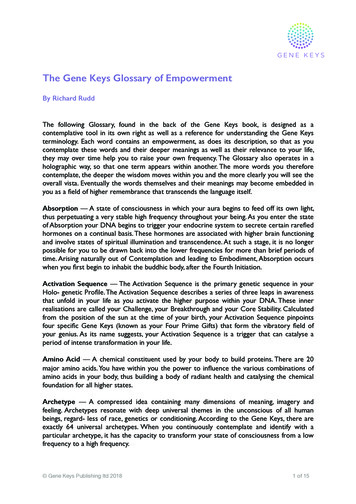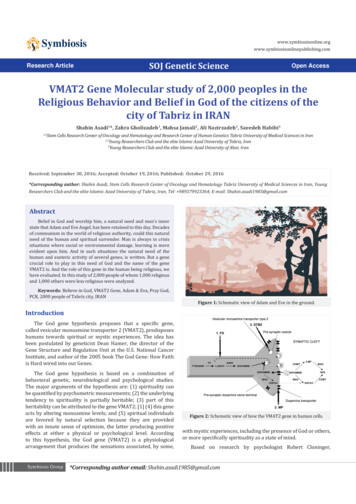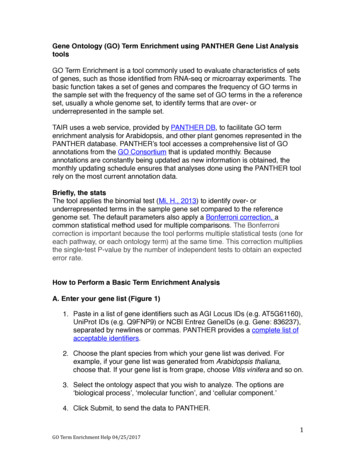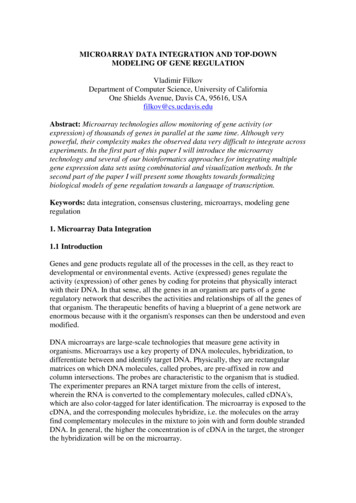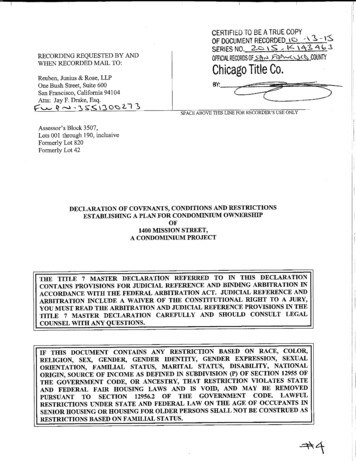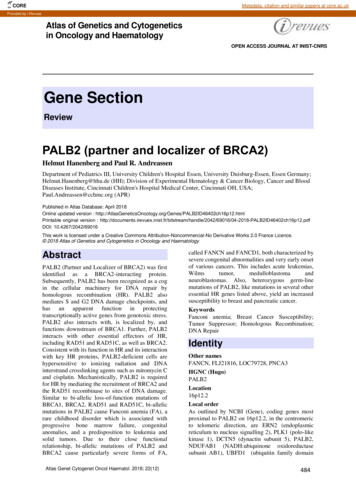
Transcription
COREMetadata, citation and similar papers at core.ac.ukProvided by I-RevuesAtlas of Genetics and Cytogeneticsin Oncology and HaematologyOPEN ACCESS JOURNAL AT INIST-CNRSGene SectionReviewPALB2 (partner and localizer of BRCA2)Helmut Hanenberg and Paul R. AndreassenDepartment of Pediatrics III, University Children's Hospital Essen, University Duisburg-Essen, Essen Germany;Helmut.Hanenberg@hhu.de (HH); Division of Experimental Hematology & Cancer Biology, Cancer and BloodDiseases Institute, Cincinnati Children's Hospital Medical Center, Cincinnati OH, USA;Paul.Andreassen@cchmc.org (APR)Published in Atlas Database: April 2018Online updated version : 2ch16p12.htmlPrintable original version : /2042/69016/04-2018-PALB2ID46402ch16p12.pdfDOI: 10.4267/2042/69016This work is licensed under a Creative Commons Attribution-Noncommercial-No Derivative Works 2.0 France Licence. 2018 Atlas of Genetics and Cytogenetics in Oncology and HaematologyAbstractPALB2 (Partner and Localizer of BRCA2) was firstidentified as a BRCA2-interacting protein.Subsequently, PALB2 has been recognized as a cogin the cellular machinery for DNA repair byhomologous recombination (HR). PALB2 alsomediates S and G2 DNA damage checkpoints, andhas an apparent function in protectingtranscriptionally active genes from genotoxic stress.PALB2 also interacts with, is localized by, andfunctions downstream of BRCA1. Further, PALB2interacts with other essential effectors of HR,including RAD51 and RAD51C, as well as BRCA2.Consistent with its function in HR and its interactionwith key HR proteins, PALB2-deficient cells arehypersensitive to ionizing radiation and DNAinterstrand crosslinking agents such as mitomycin Cand cisplatin. Mechanistically, PALB2 is requiredfor HR by mediating the recruitment of BRCA2 andthe RAD51 recombinase to sites of DNA damage.Similar to bi-allelic loss-of-function mutations ofBRCA1, BRCA2, RAD51 and RAD51C, bi-allelicmutations in PALB2 cause Fanconi anemia (FA), arare childhood disorder which is associated withprogressive bone marrow failure, congenitalanomalies, and a predisposition to leukemia andsolid tumors. Due to their close functionalrelationship, bi-allelic mutations of PALB2 andBRCA2 cause particularly severe forms of FA,Atlas Genet Cytogenet Oncol Haematol. 2018; 22(12)called FANCN and FANCD1, both characterized bysevere congenital abnormalities and very early onsetof various cancers. This includes acute mas. Also, heterozygous germ-linemutations of PALB2, like mutations in several otheressential HR genes listed above, yield an increasedsusceptibility to breast and pancreatic cancer.KeywordsFanconi anemia; Breast Cancer Susceptibility;Tumor Suppressor; Homologous Recombination;DNA RepairIdentityOther namesFANCN, FLJ21816, LOC79728, PNCA3HGNC (Hugo)PALB2Location16p12.2Local orderAs outlined by NCBI (Gene), coding genes mostproximal to PALB2 on 16p12.2, in the centromericto telomeric direction, are ERN2 (endoplasmicreticulum to nucleus signalling 2), PLK1 (polo-likekinase 1), DCTN5 (dynactin subunit 5), PALB2,NDUFAB1 (NADH:ubiquinone oxidoreductasesubunit AB1), UBFD1 (ubiquitin family domain484
PALB2 (partner and localizer of BRCA2)containing 1),synthetase 2).andEARS2(glutamyl-tRNADNA/RNAThe PALB2 protein was identified as a BRCA2interacting protein using mass spectrometry. Thiswas found to correspond to gene locus 79728(LOC79728), which encodes putative proteinFLJ21816 (Xia et al., 2006). In the same study, thefirst cDNA clone for human PALB2 was generatedusing RT-PCR. The human transcript includes 13exons arranged as diagrammed below:Exon structure of the human PALB2 gene. Exons are delineated by a vertical black line. The codingsequences are shown in grey, while non-coding sequences in exons 1 and 13 are shown in white. (Above) Theencoded protein is shown in blue with key domains and/or motifs that mediate interactions shown in black. CC,coiled-coil; ChAM, chromatin association motif; LDEETGE, extended EDGE motif.independent of the interaction of MRG15 with The human PALB2 gene (13 exons) spans 38.14 kb.(Hayakawa et al., 2010; Sy et al., 2009a).Additionally, PALB2 interacts with KEAP1, aTranscriptionsensor of oxidative stress (Ma et al., 2012).Absent confirmed splice variants, the full-lengthtranscript of PALB2 is 4,003 bp.PALB2 is essential for embryonic development;homozygous knockout of PALB2 in mice disruptsthe normal differentiation of mesoderm and resultsin embryonic lethality by E9.5 (Bowman-Colin etPALB2 has a large number of interactions with otheral., 2013; Rantakari et al., 2010).DNA damage response proteins that function inDNA repair by homologous recombination, asDescriptionillustrated below and reviewed elsewhere (Park etPALB2 contains a coiled-coil domain at its Nal., 2014b). This includes interactions with BRCA1,terminus from amino acids (a.a.) 9-44, whichBRCA2, RAD51, RAD51C and XRCC3. In thismediates interaction with BRCA1 (Sy et al., 2009b;way, PALB2 functions in a large network of HRZhang et al., 2009a; Zhang et al., 2009b). A nearbyproteins and seems to have a key role in coordinatingtheir function (Park et al., 2014b). In particular,sequence present at a.a. 88-94 in human PALB2 isdirect binding to BRCA1 mediates PALB2responsible for interaction with KEAP1 (Ma et al.,recruitment to DNA damage foci (Zhang et al.,2012). PALB2 contains a Chromatin Association2009a; Zhang et al., 2009b). Notably, KEAP1Motif (ChAM) from a.a. 395-446 and a FXLP mofifdependent ubiquitination of the PALB2 coiled-coilfrom a.a. 612-615, which binds to MRG15, therebydomain suppresses HR in G1 by inhibiting thepromoting the interaction of PALB2 with chromatininteraction of PALB2 with BRCA1 (Orthwein et al.,(Bleuyard et al., 2012; Hayakawa et al., 2010; Xie et2015). Importantly, direct interactions of the N- andal., 2012). The C-terminal WD40 domain of PALB2,C-termini of PALB2 with BRCA1 and BRCA2,from a.a. 867-1186, directly binds BRCA2 (Oliver etrespectively, physically links these tumor suppressoral., 2009), RAD51 (Buisson et al., 2010), RAD51Cproteins (Sy et al., 2009b; Zhang et al., 2009a; Zhangand XRCC3 (Park et al., 2014a), POLE (pol η)etal.,2009b).(Buisson et al., 2014) and RNF168 (Luijsterburg etal., 2017). Within the WD40 domain, there is aPALB2 also directly interacts with MORF4L1hidden nuclear protein export signal from a.a. 928(MRG15); this interaction appears to be945 (Pauty et al., 2017).ProteinKey domains in the PALB2 protein and interactions they mediate. Functional domains (or motifs) areshown in black and are identified above the diagram; the amino acids that each domain spans is noted inparentheses. Known interactions which are mediated by the particular domain or motif are shown beneath thediagram.across different tissues including the brain, boneExpressionmarrow, spleen, lung, liver, pancreas, stomach,According to The Human Protein Atlas (online),kidney, testis, ovary and skin.PALB2 is ubiquitously expressed to varying degreesAtlas Genet Cytogenet Oncol Haematol. 2018; 22(12)485
PALB2 (partner and localizer of BRCA2)LocalisationPALB2 localises to nuclei in both chromatin and thenucleoplasm during interphase (Xia et al., 2006). Inuntreated populations of human cancer cells, themajority of cells display a dispersed non-nucleolarsignal while a subset of cells also display DNAdamage foci. Treatment with agents that induceDNA damage and/or replication stress increases theassembly of nuclear DNA damage foci. Theassembly of PALB2 nuclear foci requires interactionof the protein with BRCA1 (Zhang et al., 2009a;Zhang et al., 2009b). Additionally, the recruitment ofPALB2 into foci is also promoted by MDC1, RNF8,UIMC1 (RAP80) and ABRAXAS1 (Abraxas), all ofwhich are involved in the recruitment of BRCA1(Zhang et al., 2012), and by RNF168 (Luijsterburget al., 2017). MRG15, PALB2 phosphorylated at S59and hypophosphorylated at S64, the APRINcohesion factor and phosphorylated RPA2 alsopromote the recruitment of PALB2 to sites of DNAdamage (Brough et al., 2012; Buisson et al., 2017;Hayakawa et al., 2010; Murphy et al., 2014).FunctionPALB2 acts as a typical cancer suppressor gene.Mono-allelic loss-of-function germline mutationsare associated with an increased risk of developingbreast cancer (Antoniou et al., 2014; Erkko et al.,2007; Rahman et al., 2007) and pancreatic cancer(Jones et al., 2009). Bi-allelic mutations in PALB2(FANCN) cause a severe form of Fanconi anemia,subtype FA-N, with early onset of acute myeloidleukemia, medulloblastoma, neuroblastoma andoften Wilms' tumor, leading to early death in the firstdecadeoflife(Reidetal.,2007).PALB2 is believed to act as a tumor suppressorprotein by mediating DNA repair and therebysuppressing genome instability (Park et al., 2014b).Importantly, PALB2/FANCN-deficient cells havelargely reduced levels of wild-type BRCA2 protein(Xia et al., 2007; Xia et al., 2006), reflective of a rolefor PALB2 in stabilizing the BRCA2 protein.Therefore, the phenotypes of these cells, as well asthe clinical phenotypes of FA-N patients, are verysimilar to those of cells from patients with a BRCA2/FANCD1deficiency.As demonstrated by employing reporter constructsintegrated into human cells, PALB2 has an importantrole in mediating the repair of DNA double-strandbreaks (DSBs) by homologous recombination (HR)(Xia et al., 2006). While not specifically tested forPALB2, its partner BRCA2 has an additional role inmediating HR in response to DNA interstrandcrosslinks (ICLs); ICLs are specifically repaired byFA proteins (Nakanishi et al., 2011). Consistent witha requirement for PALB2 in DNA repair by HR, anddue to largely reduced BRCA2 protein levels,PALB2-deficient cells are hypersensitive to DNAAtlas Genet Cytogenet Oncol Haematol. 2018; 22(12)interstrand crosslinking agents such as mitomycin C(MMC) and cisplatin (Xia et al., 2007; Xia et al.,2006), and to ionizing radiation (IR) (Park et al.,2014a). As further support for a role in DNA repair,PALB2-deficient cells are also hypersensitive topoly-ADP ribose polymerase (PARP) inhibitors(Buisson et al., 2010) and to aldehydes (Ghosh et al.,2014).As a mediator of HR, PALB2 recruits BRCA2 andthe RAD51 recombinase to sites of DNA damage(Xia et al., 2006). Additionally, PALB2 stabilizesBRCA2 present in chromatin (Xia et al., 2006).Biochemical experiments demonstrate that PALB2also directly binds DNA and promotes strandinvasion necessary to initiate HR (Buisson et al.,2010; Dray et al., 2010). In this process, PALB2decreases inhibition of D-loop formation mediatedby RPA and enhances HR by stabilizing RAD51filaments. Also, PALB2 interacts with pol η, therebypromoting DNA synthesis at D-loops (Buisson et al.,2014).PALB2 has additional roles in other facets of theDNA damage response, beyond its role in mediatingHR. Among these, PALB2 promotes maintenance ofG2 checkpoint arrest in response to DNA damage(Menzel et al., 2011). PALB2 is also required forchromosome stability. PALB2-deficient cellsdisplay increased breaks and radials in response toDNA damage (Bowman-Colin et al., 2013). Further,PALB2 has a role in protecting the cell fromreplication stress. Carriers of PALB2 mutationsdisplay increased firing of dormant replicationorigins (Nikkila et al., 2013) and mice with a singleamino acid knock-in of in Brca2, p.Gly25Arg, whichis deficient for binding to PALB2, display decreasedfork stability in response to hydroxyurea (Hartford etal., 2016). Homozygosity of these Brca2 knock-inmice, and also hemizygosity in combination withPalb2 and Trp53 heterozygosity, results in defects inbody size, fertility, meiosis and genome stability,and also increases tumor susceptibility (Hartford etal., 2016). Further, via its chromodomain, MRG15targets PALB2 to actively transcribed genes andprotects them from DNA damage induced bycamptothecin (Bleuyard et al., 2017).HomologyBased on HomoloGene (NCBI), the following arehomologs of the human PALB2 gene(NP 078951.2, 1186 a.a.):Chimpanzee (Pan troglodytes) XP 510877.2, 1186a.a.Rhesusmonkey(Macacamulatta)XP 001095569.2, 1135 a.a.Dog (Canis lupus familiaris) XP 850671.2, 1195a.a.Mouse (Mus musculus) NP 001074707.1, 1104 a.a.Rat (Rattus norvegicus) NP 001178532.1, 1110 a.a.Chicken (Gallus gallus) XP 004945321.1, 1341 a.a.486
PALB2 (partner and localizer of BRCA2)MutationsImplicated inGerm-line frameshift, splice site and nonsensemutations that result in truncation of at least part ofthe C-terminal WD40 domain of PALB2, whichbinds BRCA2, are linked to Fanconi anemia (Reid etal., 2007; Xia et al., 2007), as well as breast cancerand pancreatic cancer (Erkko et al., 2007; Jones etal., 2009; Rahman et al., 2007; Tischkowitz et al.,2007). Consistent with the role of PALB2 as aninteraction partner in a large DNA repair network,these mutations disrupt the binding of PALB2 withBRCA2 and other partners, thereby diminishingDNArepairbyHR.Germ-line bi-allelic and heterozygous loss-ofmutations in PALB2 are associated with differentclinical disorders and outcomes. Bi-allelicinactivating mutations of PALB2 result in Fanconianemia subtype N (FA-N, gene: FANCN), whileheterozygous inheritance of a deleterious PALB2mutation increases the lifetime risk of developingbreast and pancreatic cancer. Loss of heterozygosityhas not been consistently detected in tumors thatdevelop in carriers of heterozygous PALB2mutations (Hartley et al., 2014). How much germline mutations of PALB2 increase the risk ofdeveloping other malignancies, such as ovarian orlung cancers, remains to be determined (Phuah et al.,2013).Germ-line, as well as acquired missense mutations,have also been reported in breast cancer patients(Casadei et al., 2011). At the time of writing, 2023distinct variations were listed in Clinvar(https://www.ncbi.nlm.nih.gov/clinvar/?term palb2%5Bgene%5D) for PALB2, with 244 frameshift,110 nonsense, 43 splice site, 14 near gene/UTR, and966 missense alterations listed. Notably, the clinicalsignificance, as well as the functional significance,of most of these amino acid exchanges is unknown.These are therefore termed variants of ted by functional tests in reconstitutedPALB2-deficient FA cells that the p.L939W andp.L1143P variants in the WD40 domain of PALB2decrease the efficiency of HR and confer partialresistance to IR, when compared to cellsreconstituted with wild-type PALB2 (Park et al.,2014a). More recently, it has been demonstrated thatthe c.104T C (p.L35P) missense mutant in the Nterminus of PALB2 segregates with malignancies ina family with a strong history of breast cancer (Fooet al., 2017). The p.L35P mutant protein completelyabrogates the interaction of PALB2 with BRCA1and therefore shows no protein activity in HR assaysor in assays of cellular resistance to platinum andPARP inhibitors. The findings with p.L35Pdemonstrate that missense mutations in PALB2 canbe pathogenic. Considering the large number ofPALB2 VUS, and given the importance of PALB2functionality for determining prognosis andtreatment stratification in patients, significant effortsshould be undertaken to systematically determine thefunctional consequences of such variants on definedcellular functions. Determination of the effects ofPALB2 VUS on cellular sensitivity to PARPinhibitors, cisplatin and related drugs, and irradiationis particularly important, since PALB2 promotescellular resistance to each of these therapeuticagents.EpigeneticsHypermethylation of CpG islands in the PALB2promoter has been observed in a subset of cases ofinherited and sporadic breast cancer, and in ovariancancer (Potapova et al., 2008).Atlas Genet Cytogenet Oncol Haematol. 2018; 22(12)Fanconi Anemia (FA)Just seven months after the identification andcharacterization of PALB2 as a novel BRCA2binding protein (Xia et al., 2006), two independentgroups identified a total of eight FA patients withbiallelic mutations in PALB2: [(Xia et al., 2007):n 1, (Reid et al., 2007): n 7]. These patientsexhibited a severe FA phenotype with pronouncedcongenital abnormalities and a high incidence ofmalignancies before age seven that was similar to thephenotype described for BRCA2-deficient FANCD1patients (Alter et al., 2007; Hirsch et al., 2004;Wagner et al., 2004). Notably, these eight lastoma, 3X Wilms tumors, 2X acutemyeloid leukemia, 1X neuroblastoma and 1Xhemangioendothelioma) before five years of age.One German patient experienced three differentmalignancies at 12 months of age, and there werecases of breast and pancreatic cancers present in thefamilies (Reid et al., 2007). PALB2 was the 12 thidentified FA gene, defining the FA-Ncomplementationgroup.At present, 22 FA or FA-like genes have beenidentified (Nepal et al., 2017). Except for the Xlinked FANCB and the autosomal dominant RAD51(FANCR), FA genes are autosomal recessive tumorsuppressor genes. Based on the central activationstep in the FA pathway, the monoubiquitination ofthe FANCD2/ FANCI protein dimer, one candistinguish the so-called early (or upstream) FAgenes, FANC -A, -B, -C, -E, -F, -G, -L, -M, UBE2T(FANC-T) with no ubiquitination of FANCD2/Iwhen mutated (Mamrak et al., 2017; Nepal et al.,2017). In contrast, late/downstream FA genes are notrequired for monoubiquitination of FANCD2 andFANCI. These late genes include BRCA2(FANCD1),BRIP1(FANCJ),FANCN/PALB2,/RAD51C (FANCO), RAD51(FANCR), BRCA1 (FANCS), XRCC2 (FANCU),MAD2L2 (FANCV/polTheta) and RFWD3(FANCW). Most FA patients have bi-allelic487
PALB2 (partner and localizer of BRCA2)mutations in the upstream FA genes, especiallyFANCA, FANCC and FANCG, and show thecharacteristic clinical features of FA. These clinicalfeatures include progressive bone marrow failurearound 7.6 years of age, various congenitalanomalies, and a predisposition to acute myeloidleukemia and an assortment of solid tumors thatoccur in the second and third decade of life (Kutleret al., 2003). Congenital anomalies observed in FApatients can include microcephaly, short stature, skinpigmentation defects, hypogonadism, and radial rayanomalies. A significant number of FA patients alsoexperience endocrine abnormalities (Rose et al.,2012).In contrast to other FA complementation groups, FApatients that harbour biallelic mutations inPALB2/FANCN or its partner BRCA2/FANCD1show clinically indistinguishable phenotypes ofsevere FA characterized by a very early onset andhigh penetrance of cancers before age seven (Reid etal., 2007). More than 90% of patients succumb totheir malignancies before ten years of age. Notably,the spectrum of cancers found in FA patients fromthe FANCN/PALB2 and FANCD1/BRCA2complementation groups is different than for otherFA complementation groups, including frequentoccurrences of medulloblastoma, Wilms tumor,neuroblastoma and hepatoblastomas (Alter et al.,2007; Tischkowitz and Xia, 2010). Bone marrowfailure is usually not observed in FA-N patients(Reidetal.,2007).On a cellular level, FA including the FA-N/PALB2complementation group is a chromosome instabilitysyndrome. Notably, FA patients are hypersensitiveto agents which induce DNA interstrand crosslinks(ICLs). Specifically, cells from FA patients displaya characteristic spontaneous and ICL-inducedchromosome instability; this phenotype is typicallyutilized to diagnose FA (Auerbach, 2009). Recently,without functional testing, next generationsequencing based strategies have also beenemployed to diagnose FA in patients and at the sametime identify the defective gene (De Rocco et al.,2014). Additionally, cells from FA patients displayaccumulation in G2-M of the cell cycle in responseto ICLs (Bogliolo and Surralles, 2015). Othercellular functions affected in cells with defects in theFA pathway include sensitivity to aldehydes andoxygen, excessive cytokine production, and defectsin the spindle assembly checkpoint, autophagy,cellular reprograming, unwinding of quadruplex andtriplex DNA and microsatellite instability (Boglioloand Surralles, 2015). Correction of the cellularphenotypes by expression of the appropriate FAgene can be utilized to determine the FAcomplementation group (Chandra et al., 2005;Hanenberg et al., 2002; Virts et al., 2015). Forpatients with a deficiency for FANCA, stem cellAtlas Genet Cytogenet Oncol Haematol. 2018; 22(12)gene therapy might become a new treatment option(Hanenberg et al., 2017).Breast CancerBack-to-back with the identification of PALB2 asthe 12th FA gene, Rahman et al. reported theidentification of 10 out of 923 individuals (1.1%)from familial breast cancer pedigrees with monoallelic loss-of-function germ-line mutations inPALB2 (Rahman et al., 2007). A lower frequency ofPALB2 germ-line mutation (0.5 to 1%) was found inpatients with or without a positive family history(Erkko et al., 2007; Foulkes et al., 2007). Further,founder mutations were detected in Finland (Erkkoet al., 2007) and Canada (Foulkes et al., 2007).The largest study to date included 311 women and51 men from 154 families with loss-of-functiongerm-line PALB2 mutations, of whom 229 womenand 7 men developed breast cancer. Biostatisticalanalyses revealed that the risk of developing breastcancer for PALB2 mutation carriers was increasedby a factor of 9.07 (95% CI, 5.72 to 14.39) whencompared to the breast cancer incidence in thegeneral population (Antoniou et al., 2014). Thecumulative risk of female heterozygous PALB2germ-line mutation carriers to develop breast cancerby the age of 70 was as high as 35%. Thus, alongwith BRCA1 and BRCA2, PALB2 is among thegenes that confer the highest breast cancer risk whenmutated. In a recent German study of 5589 breastcancer patients without mutations in BRCA1/2, lossof-function mutations in PALB2 accounted for1.15% of cases and were also significantlyassociated with bilateral breast cancer occurrence(Hauke et al., 2018). Only 8 out of 40 patents withPALB2 germ-line mutations belonged to the triplenegative breast cancer subtype (Hauke et al., 2018).Breast cancer causing mutations of PALB2 includeestablished nonsense, frameshift and splice sitemutations, which all are thought to compromise therole of PALB2 in cellular responses to DNAdamage. However, it is noteworthy that almost 50%of the PALB2 sequence alterations listed in ClinVarare missense variations of unknown clinical andfunctional significance. Importantly, loss of functionof PALB2 is synthetically lethal with radiation,PARP inhibitors, and cisplatin and relatedcompounds. While tumors, which are driven bymutations in PALB2, typically have loss of functionof PALB2, normal tissues retain a functional copy ofthis gene. As such, radiation and/or PARP inhibitorsor platinum compounds may be particularly effectiveagainst tumor cells with bi-allelic PALB2 mutations.Interestingly, the relative risk for ovarian cancer wasonly increased non-significantly to 2.31 for PALB2mutation carriers (Antoniou et al., 2014). This issurprising, as the PALB2 protein physically interactswith the products of other ovarian cancer488
PALB2 (partner and localizer of BRCA2)susceptibility genes, specifically BRCA1, BRCA2and RAD51C (Park et al., 2014b).mutation in PALB2 in Finnish cancer families. Nature. 2007Mar 15;446(7133):316-9Pancreatic CancerFoo TK, Tischkowitz M, Simhadri S, Boshari T, Zayed N,Burke KA, Berman SH, Blecua P, Riaz N, Huo Y, Ding YC,Neuhausen SL, Weigelt B, Reis-Filho JS, Foulkes WD, XiaB. Compromised BRCA1-PALB2 interaction is associatedwith breast cancer risk. Oncogene. 2017 Jul20;36(29):4161-4170While BRCA2, which encodes a partner of thePALB2 protein, is the most frequently mutated genein hereditary pancreatic cancer (Shindo et al., 2017;Zhen et al., 2015), mutation of PALB2 is also animportant cause of this disease (Jones et al., 2009).To date, truncating loss-of-function germ-linemutations in PALB2 have been associated with thedevelopment of pancreatic cancer. In some pedigreesof families with inherited pancreatic cancer, breastand other cancers have also been observed (Blancoet al., 2013; Zhen et al., 2015).Ghosh S, Sur S, Yerram SR, Rago C, Bhunia AK, HossainMZ, Paun BC, Ren YR, Iacobuzio-Donahue CA, Azad NA,Kern SE. Hypersensitivities for acetaldehyde and otheragents among cancer cells null for clinically relevantFanconi anemia genes. Am J Pathol. 2014 Jan;184(1):26070ReferencesHartford SA, Chittela R, Ding X, Vyas A, Martin B, BurkettS, Haines DC, Southon E, Tessarollo L, Sharan SK.Interaction with PALB2 Is Essential for Maintenance ofGenomic Integrity by BRCA2. PLoS Genet. 2016Aug;12(8):e1006236Bleuyard JY, Fournier M, Nakato R, Couturier AM, Katou Y,Ralf C, Hester SS, Dominguez D, Rhodes D, Humphrey TC,Shirahige K, Esashi F. MRG15-mediated tethering ofPALB2 to unperturbed chromatin protects active genes fromgenotoxic stress. Proc Natl Acad Sci U S A. 2017 Jul18;114(29):7671-7676Hartley T, Cavallone L, Sabbaghian N, Silva-Smith R,Hamel N, Aleynikova O, Smith E, Hastings V, Pinto P,Tischkowitz M, Tomiak E, Foulkes WD. Mutation analysis ofPALB2 in BRCA1 and BRCA2-negative breast and/orovarian cancer families from Eastern Ontario, Canada.Hered Cancer Clin Pract. 2014;12(1):19Bowman-Colin C, Xia B, Bunting S, Klijn C, Drost R,Bouwman P, Fineman L, Chen X, Culhane AC, Cai H, RodigSJ, Bronson RT, Jonkers J, Nussenzweig A, KanellopoulouC, Livingston DM. Palb2 synergizes with Trp53 to suppressmammary tumor formation in a model of inherited breastcancer. Proc Natl Acad Sci U S A. 2013 May21;110(21):8632-7Hayakawa T, Zhang F, Hayakawa N, Ohtani Y, ShinmyozuK, Nakayama J, Andreassen PR. MRG15 binds directly toPALB2 and stimulates homology-directed repair ofchromosomal breaks. J Cell Sci. 2010 Apr 1;123(Pt 7):112430Brough R, Bajrami I, Vatcheva R, Natrajan R, Reis-Filho JS,Lord CJ, Ashworth A. APRIN is a cell cycle specific BRCA2interacting protein required for genome integrity and apredictor of outcome after chemotherapy in breast cancer.EMBO J. 2012 Mar 7;31(5):1160-76Jones S, Hruban RH, Kamiyama M, Borges M, Zhang X,Parsons DW, Lin JC, Palmisano E, Brune K, Jaffee EM,Iacobuzio-Donahue CA, Maitra A, Parmigiani G, Kern SE,Velculescu VE, Kinzler KW, Vogelstein B, Eshleman JR,Goggins M, Klein AP. Exomic sequencing identifies PALB2as a pancreatic cancer susceptibility gene. Science. 2009Apr 10;324(5924):217Buisson R, Dion-Côté AM, Coulombe Y, Launay H, Cai H,Stasiak AZ, Stasiak A, Xia B, Masson JY. Cooperation ofbreast cancer proteins PALB2 and piccolo BRCA2 instimulating homologous recombination. Nat Struct Mol Biol.2010 Oct;17(10):1247-54Luijsterburg MS, Typas D, Caron MC, Wiegant WW, vanden Heuvel D, Boonen RA, Couturier AM, Mullenders LH,Masson JY, van Attikum H. A PALB2-interacting domain inRNF168 couples homologous recombination to DNA breakinduced chromatin ubiquitylation. Elife. 2017 Feb 27;6Buisson R, Niraj J, Rodrigue A, Ho CK, Kreuzer J, Foo TK,Hardy EJ, Dellaire G, Haas W, Xia B, Masson JY, Zou L.Coupling of Homologous Recombination and theCheckpoint by ATR. Mol Cell. 2017 Jan 19;65(2):336-346Ma J, Cai H, Wu T, Sobhian B, Huo Y, Alcivar A, Mehta M,Cheung KL, Ganesan S, Kong AN, Zhang DD, Xia B.PALB2 interacts with KEAP1 to promote NRF2 nuclearaccumulation and function. Mol Cell Biol. 2012Apr;32(8):1506-17Casadei S, Norquist BM, Walsh T, Stray S, Mandell JB, LeeMK, Stamatoyannopoulos JA, King MC. Contribution ofinherited mutations in the BRCA2-interacting protein PALB2to familial breast cancer. Cancer Res. 2011 Mar15;71(6):2222-9Chandra S, Levran O, Jurickova I, Maas C, Kapur R,Schindler D, Henry R, Milton K, Batish SD, Cancelas JA,Hanenberg H, Auerbach AD, Williams DA. A rapid methodfor retrovirus-mediated identification of complementationgroups in Fanconi anemia patients. Mol Ther. 2005Nov;12(5):976-84Menzel T, Nähse-Kumpf V, Kousholt AN, Klein DK, LundAndersen C, Lees M, Johansen JV, Syljuåsen RG,Sørensen CS. A genetic screen identifies BRCA2 andPALB2 as key regulators of G2 checkpoint maintenance.EMBO Rep. 2011 Jul 1;12(7):705-12Murphy AK, Fitzgerald M, Ro T, Kim JH, Rabinowitsch ted RPA recruits PALB2 to stalled DNAreplication forks to facilitate fork recovery. J Cell Biol. 2014Aug 18;206(4):493-507Dray E, Etchin J, Wiese C, Saro D, Williams GJ, HammelM, Yu X, Galkin VE, Liu D, Tsai MS, Sy SM, Schild D,Egelman E, Chen J, Sung P. Enhancement of RAD51recombinase activity by the tumor suppressor PALB2. NatStruct Mol Biol. 2010 Oct;17(10):1255-9Nakanishi K, Cavallo F, Perrouault L, Giovannangeli C,Moynahan ME, Barchi M, Brunet E, Jasin M. Homologydirected Fanconi anemia pathway cross-link repair isdependent on DNA replication. Nat Struct Mol Biol. 2011Apr;18(4):500-3Erkko H, Xia B, Nikkilä J, Schleutker J, Syrjäkoski K,Mannermaa A, Kallioniemi A, Pylkäs K, Karppinen SM,Rapakko K, Miron A, Sheng Q, Li G, Mattila H, Bell DW,Haber DA, Grip M, Reiman M, Jukkola-Vuorinen A,Mustonen A, Kere J, Aaltonen LA, Kosma VM, Kataja V,Soini Y, Drapkin RI, Livingston DM, Winqvist R. A recurrentNepal M, Che R, Zhang J, Ma C, Fei P. Fanconi AnemiaSignaling and Cancer. Trends Cancer. 2017 Dec;3(12):840856Atlas Genet Cytogenet Oncol Haematol. 2018; 22(12)Nikkilä J, Parplys AC, Pylkäs K, Bose M, Huo Y, BorgmannK, Rapakko K, Nieminen P, Xia B, Pospiech H, Winqvist R.489
PALB2 (partner and localizer of BRCA2)Heterozygous mutations in PALB2 cause DNA replicationand damage response defects. Nat Commun. 2013;4:2578Oliver AW, Swift S, Lord CJ, Ashworth A, Pearl LH.Structural basis for recruitment of BRCA2 by PALB2. EMBORep. 2009 Sep;10(9):990-6Orthwein A, Noordermeer SM, Wilson MD, Landry S,Enchev RI, Sherker A, Munro M, Pinder J, Salsman J,Dellaire G, Xia B, Peter M, Durocher D. A mechanism forthe suppression of homologous recombination in G1 cells.Nature. 2015 Dec 17;528(7582):422-6Park JY, Singh TR, Nassar N, Zhang F, Freund M,Hanenberg H, Meetei AR, Andreassen PR. Breast cancerassociated missen
UIMC1 (RAP80) and ABRAXAS1 (Abraxas), all of which are involved in the recruitment of BRCA1 (Zhang et al., 2012), and by RNF168 (Luijsterburg et al., 2017). MRG15, PALB2 phosphorylated at S59 and hypophosphorylated at S64, the APRIN cohesion factor and phosphorylated RPA2 also promote the recruitment of PALB2 to sites of DNA

